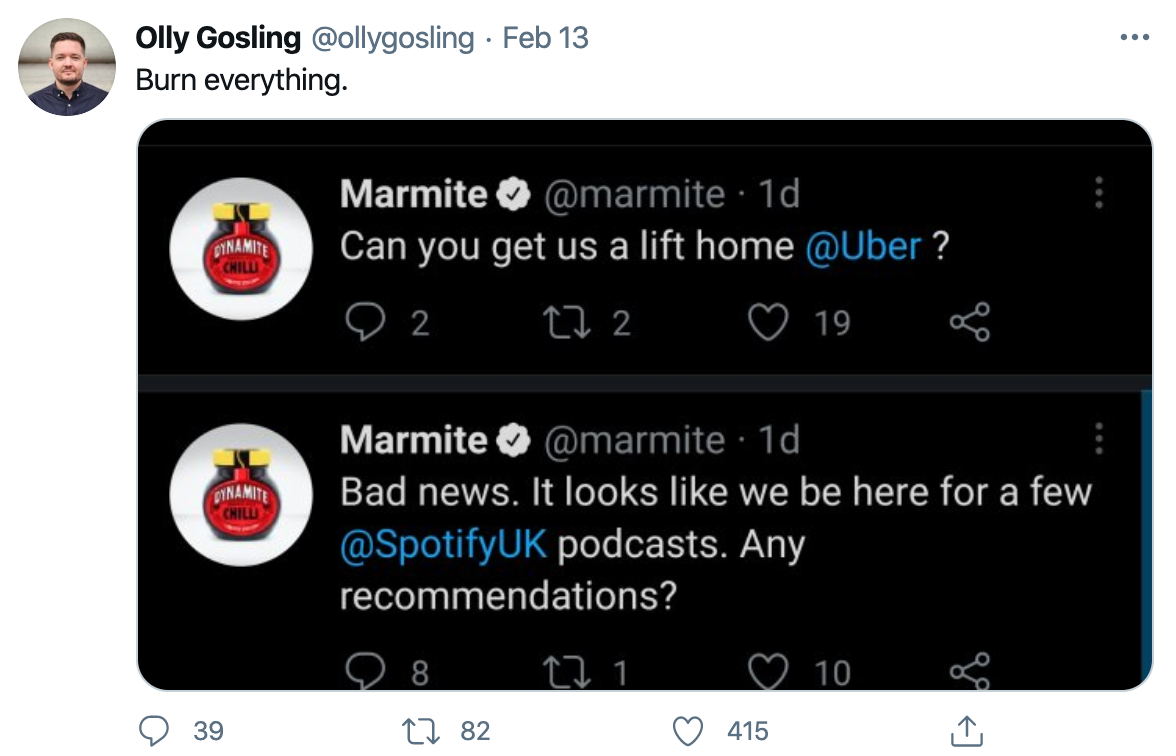
THIS IS THE WAY THE WORLD ENDS - NOT WITH A BANG, BUT WITH BRAND BANTER
MARA DETTMANN
15/02/2021
Mara Dettmann looks at whether we need to get over our industry snobbishness when it comes to brands engaging each other on social media.
Disclaimer: Weetabix and Heinz are both BBH clients, but we were not involved in the featured social executions.
It all started on 9 February when Weetabix tweeted an unholy combination of its popular breakfast cereal topped with baked beans.
As a non-Brit, the appeal of these two national UK staples mystifies me at the best of times. The internet, however, went wild over Weetabeans and the results were pretty impressive:
It drove fame
The tweet got hundreds of thousands of engagements from other brands, the public, and accounts including the US Embassy in London. It also travelled beyond social to the UK Parliament and got extensive coverage in publications around the world – which matters because campaigns designed to create fame have been proven to outperform other campaigns on all business metrics.
It drove interest
As Google Trends shows, it’s the highest search interest in Weetabix has been...ever. Not just in the UK, but also around the world.
It drove sales
Though it’s a bit early to assess the longer term impact, some preliminary reports suggest that there’s already been an uplift in Weetabix sales.
In short, it did everything that could be hoped for a social activation.
So, a week on, why is Marketing Twitter cringing?
And why did Marmite’s attempts to get chatty with other brands on Twitter later that week incur not just disdain, but outright contempt?
Ditto for the Facebook brands flirting amongst themselves – and Waitrose and John Lewis hitting on each other (never mind that they’re related).
It could be that marketers are bubble-dwelling snobs, jealous of when someone else can tap into populist sensibilities better than they do.
Or that people’s apparent delight at seeing brands interact appears to disprove core tenets of marketing – like the principle that people don’t care about brands.
But that’s an oversimplification. We may live in bubbles and there might be some snobbery, but in most cases, the disdain comes from the fact that this “brandter” generally doesn’t tie back to any of these brands’ longer term strategy – nor does it further their creative ambition. While the occasional attempt to engage other brands can be effective in gaining short-term attention (and some of it’s relatively witty), as a long-term social strategy it’s unsustainable. It prioritises quick engagement over longer term brand building and sets an unfortunate precedent for clients who want to cook up their own attempts at quick social fame.
So how should brands actually try to create fame on social?
Now I actually think Weetabix got it right.
Looking at Weetabix’s Twitter, the tweet was part of a series of horrifying food combinations where Weetabeans was the one that got lucky (the below Martabix also performed well for an organic tweet, though not quite as spectacularly).
It’s the other brands jumping on the bandwagon who turned the situation into a screaming match, trying to out-share-of-voice each other.
Marmite got it wrong from the beginning by aiming for brandter as a starting point, while the Facebook accounts clearly just interacted with themselves.
Also, Weetabix knew when to stop. Marmite continued, and became increasingly desperate in reaching out to any brands.
Most importantly, Weetabix decided to be a proactive newsmaker. In the world of social newsrooms where reactiveness is the end goal, it’s easy to forget that brands can actually set the agenda themselves. So how do you get there?
Think about how you can reflect and add to popular culture
It might seem self-evident, but all fame-driving social activations start with strong insights rooted in popular culture. For example, when Tesco drove conversation (and sales) in January 2020 by reducing Freddo chocolates to 10p, this was based on the insight that the Freddo bar represents a unique intersection of value and nostalgia.
Look beyond PR days
About 80% of social conversation around PR days is driven by brands asking if we’re partaking in #NationalGinDay or suggesting what we get our besties for #FriendshipDay. Heinz didn’t share Weetabeans for #NationalWeirdFoodComboDay – they shared it because the timing was right for them.
Keep it true to your brand
If your social activation doesn’t ladder up to your larger brand strategy, you probably shouldn’t be posting it. This doesn’t mean that the social activation couldn’t have been done by another brand – sometimes an execution comes down to being the first mover.
Don’t underestimate the element of luck
Don’t expect every attempt to create a fame-driving social activation to be a smashing success – there’s always some element of fortuitousness to it because even though much of marketing follows scientific principles, part of it is also an art.









